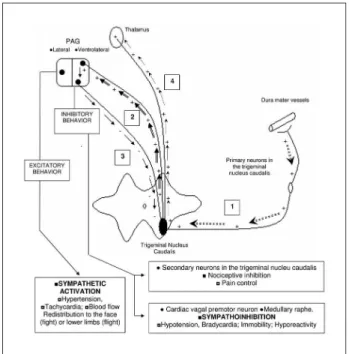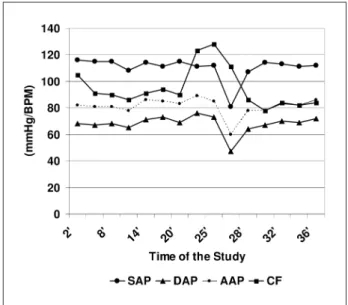Arq Neuropsiquiatr 2008;66(1):77-79
77
EPISODIC MIGRAINE ASSOCIATED WITH POSTURAL
ORTHOSTATIC TACHYCARDIA SYNDROME
AND VASOVAGAL SYNCOPE
Migraine triggers neuromediated syncope
Elcio Juliato Piovesan
1, Claudia Ferreira Sobreira
2, Rosana Herminia Scola
1, Paulo José Lorenzoni
1,
Marcos Cristiano Lange
1, Lineu Cesar Werneck
1, Débora Smith
3, Stephen Silberstein
4MIGRâNEA EPISóDICA ASSOCIADA COM SíNDROME DA TAqUICARDIA ORTOSTáTICA POSTURAL E SíNCOPE VASOVAGAL: MIGRâNEA DESEN CADEIA SíNCOPE NEUROMEDIADA
1Neurology Service, 3Cardiology Service, Internal Medicine Department, Hospital de Clínicas, Federal University of Paraná (UFPR), Curitiba PR, Brazil; 2Department of Neurology, Psychiatry and Medical Psychology, Ribeirão Preto Faculty of Medicine, University of São Paulo (USP), Ribeirão Preto SP,
Brazil; 4Jefferson Headache Center, Thomas Jefferson University Hospital, Philadelphia, PA, USA.
Received 2 August 2007, received in inal form 29 November 2007. Accepted 5 January 2008.
Dr. Elcio Juliato Piovesan – Hospital de Clínicas da UFPR - Rua General Carneiro 181 / 12 andar / Sala 1236 - 80060-900 Curitiba PR - Brasil. E-mail: piovesan@avalon.sul.com.br
Migraine is a common episodic headache disorder characterized by attacks consisting of various combina-tions of headache, neurologic, gastrointestinal and auto-nomic symptoms. Autoauto-nomic symptoms, such as a cold feeling, increased urination, anorexia, diarrhea, constipa-tion and luid retenconstipa-tion1, can occur during the
premoni-tory phase, and nausea, vomiting, diarrhea, cutaneous va-soconstriction (pallor), vasodilation (lushing), piloerec-tion and diaphoresis can occur during the pain phase2.
Migraine patients with accompanying autonomic symp-toms seem to experience their pain more unilateral and more severe than non autonomic migraine patients. Stud-ies of autonomic nervous system dysfunction in migraine have been performed2. Cardiovascular tests, vasomotor
reactions to temperature changes and responses to phar-macological tests, and changes in biochemical parame-ters suggest abnormalities (hypo- or hyperfunctioning) of both the sympathetic and parasympathetic nervous sys-tems2. These inconsistent indings may be explained by
different types of autonomic dysregulation. Syncope and migraine are both highly prevalent in the general popu-lation3. Both disorders occur together more frequently
than chance would predict3, i.e., they are comorbid.
Stud-ies using the orthostatic (tilt) test suggest that migraine patients have vagal hyperactivity and α-sympathetic sys-tem hypoactivity2. Migraineurs may have a genetic
predis-position leading to autonomic nervous system (ANS) dys-function. The link between migraine and abnormal ANS function is unclear. ANS dysfunction may be involved in both increased susceptibility to migraine headaches and
increased response to triggers. Migraine patients with typ-ical autonomic symptoms, such as postural orthostatic tachycardia syndrome (POTS) and vasovagal syncope (VS), as well as patients with migraine with prolonged aura, are potential candidates for genetic studies4. Mitochondrial
dysfunction may play a role in migraine pathophysiolo-gy4-6. It is not known whether the mitochondrion
(encod-ed by the nuclear and mitochondrial genomes) is the pri-mary site of the dysfunction, or whether the mitochon-drial disturbance occur secondary to another cause6.
Mi-tochondria may play a role in the genesis of migraine, es-pecially in these groups (migraine plus autonomic symp-toms)4,5. Connecting networks exist between pain and
au-tonomic functions in the brain (Fig 1); thus pain can pro-duce autonomic symptoms.
We describe a group of patients in whom autonomic symptoms (POTS and VS) occurred only during migraine attacks. We also studied the presence of the mitochondri-al DNA (mtDNA) A3243G5 point mutation, common in
pa-tients with mitochondrial encephalomyopathy with lactic acidosis and stroke-like episodes (MELAS).
METHOD
Arq Neuropsiquiatr 2008;66(1)
78
Episodic migraine Piovesan et al.
irst attack was 17.23±3.20 years; the average number of attacks was 2.3±1.2 per month. Patients with other autonomic symptoms or with isolated POTS, isolated VS, or POTS plus VS not associ-ated with migraine were excluded. All six patients were studied using brain magnetic resonance imaging, electroencephalograms, tilt-table test and analysis of the A3243G point mutation in mi-tochondrial DNA (mtDNA).
Tilt protocol consisted in 70o angulation during 30 minutes after a supine rest for 10 minutes. A positive result during tilt-ta-ble test was considered according to the literature7,8. Analysis of the A-to-G mutation at position 3243 of the mtDNA was done by the PCR-RFLP (polymerase chain reaction/restriction fragment length polymorphism) method using DNA from peripheral blood lymphocytes, as previously described3,9. The control group for DNA mutation consisted of two patients with MELAS. Prophy-lactic treatment for migraine was not used during the investiga-tion protocol. All subjects provided written informed consent, as required by appropriate local (Human Ethical committee of Universidade Federal do Paraná) committees on the protection of research subjects.
RESULTS
All patients had normal MRIs and electroencepha-lograms. All patients had POTS and subsequent VS dur-ing the tilt-table test without pharmacologic induction. The average time to onset of symptoms was 16.4±5.2 min-utes. Only two patients had headache during the tilt-table test. Both cases related that headache is different of the usual migraine attacks. We found an association between migraine, POTS and VS in 0.18% of our migraine patients. The A3243G mutation was not detected by the PCR-RFLP method in our six migraineurs with migraine/POTS/VS, but was detected in the two MELAS patients in the con-trol group (see Table, Figs 2 and 3).
DISCUSSION
Our group of migraine patients present autonomic symptoms such as POTS and VS after pain onset. DNA studies showed that the A3243G point mutation was not
Fig 1. Interaction between migraine and autonomic symptoms: (Step 1) primary nociceptive activation of the dura mater; (Step 2) activation of the ventrolateral periaqueductal gray substance (PAG); (Step 3) in-hibitory behavior of the ventrolateral PAG over the trigeminal nu-cleus caudalis; (Step 4) balance between different excitatory and in-hibitory potentials and activation of the thalamus.
Table. Case descriptions: clinical features; headache intensity measured according to the visual analogue scale (VAS); frequency (in per-cent) of postural orthostatic tachycardia syndrome (POTS) and vasovagal syncope (VS) symptoms; results of the tilt-table test and time to onset of autonomic symptoms; and results of DNA testing (see Fig 1).
Case Gender Age Age at
irst attack (years)
Attacks per month
First symptoms
VAS
Frequency of subsequent
symptoms
Tilt-table test DNA
(A3243G point mutation)
1 Female 36 16 3 Headache
(VAS-8)
25% POTS and VS
Positive 20 min after
Absent
2 Female 19 14 2 Headache
(VAS-9)
22% POTS and VS
Positive 18 min after
Absent
3 Female 22 16 4 Headache
(VAS-9)
29% POTS and VS
Positive 15 min after
Absent
4 Female 35 21 3 Headache
(VAS-10)
31% POTS and VS
Positive 18 min after
Absent
5 Male 36 11 2 Headache
(VAS-8)
24% POTS and VS
Positive 22 min after
Absent
6 Male 24 22 2 Headache
(VAS-8)
22% POTS and VS
Positive 27 min after
Arq Neuropsiquiatr 2008;66(1)
79
Episodic migraine Piovesan et al.
present in these patients. Why patients develop autonom-ic symptoms, such as vasovagal syncope, during migraine attacks is not clear3. A small subset of patients develop
autonomic disorders only after the onset of migraine headache. In these patients migraine pain probably trig-gers neuromediated syncope (Table). Autonomic-nervous-system-related syncope is common, with a life prevalence of 46% in migraineurs10. This can be confused with
epi-lepsy. We have shown that migraine patients can develop loss of consciousness as a result of neuromediated syn-cope (Fig 1).
The association between migraine and abnormal mi-tochondrial function has been suggested on clinical, bio-chemical and neuroradiological grounds1. A few studies
have examined mtDNA mutations in high risk subgroups
of migraineurs: patients with migraine with or without aura selected from pedigrees with a maternal mode of transmission, patients with cluster headache, patients with migrainous cerebral infarction, and patients with sporadic hemiplegic migraine4,6.
Most but not all studies have not detected mtDNA mutations in migraine patients4,11. Despite the negative
re-sults, some speculate that mtDNA mutations could con-tribute to the pathogenesis of migraine4.
We looked for, but did not ind any mtDNA MELAS A3243G point mutation, the most common mutation in mi-tochondrial diseases. MELAS typically presents with severe migraine-like symptoms, and the A3243G mutation was previously found in 6% of migraine patients from another subgroup (with juvenile occipital migraine stroke)3-5,12,13.
The physiologic link between migraine and autonomic dysfunctions probably occurs in the PAG (speciically, in the ventrolateral region) and hypothalamus. Nociceptive input may, trigger an inhibitory reaction from the PAG to the trigeminal nucleus caudalis, triggering secondary sympathoinhibition. In our study, 0.18% of the migraine patients had coexistant POTS and VS during their migraine attacks. No mitochondrial dysfunction (mtDNA A3243G point mutation) was detected in this group.
REfERENCES
1. Silberstein SD, Saper JR, Freitag FG. Migraine: diagnosis and treatment. In Silberstein SD, Lipton RB, Dalessio DJ (Eds). Wolff’s headache and other head pain. Seventh edition. New York: Oxford University Press, 2001:101-237.
2. Benjelloun H, Birouk N, Slaoui I et al. Autonomic proile of patients with migraine. Neurophysiol Clin 2005;35:127-134.
3. Brignole M, Alboni P, Benditt DG et al. Guidelines on management (diag-nosis and treatment) of syncope – update 2004. Europace 2004;6:467-537. 4. Montagna P. Molecular genetics of migraine headaches: a review.
Cephalalgia 2000;20:3-14.
5. Di Gennaro G, Buzzi MG, Ciccarelli O, et al. Assessing the relative in-cidence of mitochondrial DNA A3243G in migraine without aura with maternal inheritance. Headache 2000;40:568-571.
6. Haan J, Terwindt GM, Maassen JA, et al. Search for mitochondrial DNA mutations in migraine subgroups. Cephalalgia 1999;19:20-22. 7. Brignole M, Menozzi C, Del Rosso A, et al. New classiication of hae
-modynamics of vasovagal syncope: beyond the VASIS classiication. Europace 2000;2:66-76.
8. Grubb BP, Kanjwal MY, Kosinski DJ. Review: the postural orthostatic tachycardia syndrome: current concepts in pathophysiology, diagno-sis and management. J Interv Card Electrophysiol 2001;5:9-16. 9. Obermann M, Yoon MS, Dommes P et al. Prevalence of trigeminal
au-tonomic symptoms in migraine: a population-based study. Cephalal-gia 2007;27:504-509.
10. Thijs RD, Kruit MC, van Buchem MA, et al. Syncope in migraine: the population-based CAMERA study. Neurology 2006;66:1034-1037. 11. Rozen TD, Shanske S, Otaegui D, et al. Study of mitochondrial DNA
mutations in patients with migraine with prolonged aura. Headache 2004;44:674-677.
12. Majamaa K, Turkka J, Karppa M, Winqvist S, Hassinen IE. The com-mon MELAS mutation A3243G in mitochondrial DNA acom-mong young patients with an occipital brain infarct. Neurology 1997;49:1331-1334. 13. Ciafaloni E, Ricci E, Shanske S, et al. MELAS: clinical features,
biochem-istry, and molecular genetics. Ann Neurol 1992;31:391-398.
Fig 2. PCR-RFLP analysis to detect the A3243G mutation showed that the it was absent in the six migraineurs with POTS and VS but was present in the two MELAS control subjects.

